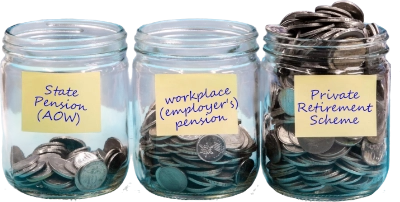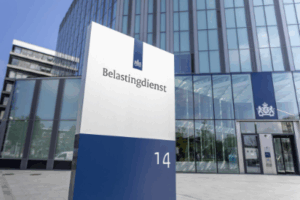Is a Private Retirement Scheme Right for You?

The New Pension Act will change how pensions work for everyone in the Netherlands by 2027. When you consider this upcoming shift, alongside a dynamic job market and the rapidly growing number of self-employed professionals, whose numbers total 1,770,864 (according to data from 31 March 2025), it’s easy to see why so many are thinking about their future financial security.
With these changes unfolding, it’s no surprise that more and more individuals are exploring their pension options, including the third pillar of the Dutch pension system – a private retirement scheme.

We also go into detail about the other two pillars – state pension (AOW) and workplace (employer’s) pension. While most residents and workers may benefit from the first two pillars, a private pension offers an excellent way to broaden your retirement savings.
What Is a Private Retirement Scheme?
It’s a type of supplementary scheme also called a self-investment personal pension. It is largely recommended for independent workers who are not covered by an employer’s pension or their CLA (Collective Labour Agreement). An individual pension plan is also available to everyone who wants to build up additional savings and achieve long-term financial independence. Private retirement schemes are generally more flexible and offer a range of benefits that the other two pillars of the retirement system lack.
Private pensions enable the self-employed (ZZP’ers), contractors following the WAADI, who are only covered by AOW, and those not part of a CLA to top up on their retirement savings. But really anyone can choose to take advantage of these alternative forms of retirement savings.
A private retirement scheme enables independent workers to:
- Build supplemental retirement capital
- Optimise tax advantages
- Ensure pension continuity
- Maintain a standard of living post-retirement
Types of Private Retirement Schemes in the Netherlands
Aside from property investments and company shares, which we won’t get into in this article, you can also make use of an individual pension plan to ensure your financial health when you get older. Private retirement schemes are distributed by either banks or investment companies that offer different packages so you can create a personalised pension plan. You can explore the most popular options for a private retirement plan below.
Retirement Annuity Contracts (Lijfrenteverzekering, or just lijfrente)
Annuity contracts are, at their core, a form of insurance and are widely viewed as a traditional pension product. They allow you to make regular contributions, which are transformed into a guaranteed stream of income upon retirement.
A great perk of annuities is the flexibility they offer. You can choose to either pay a fixed amount each month and leave it as it is or have your money invested so your payments could increase or decrease, depending on how well the investment performs.
With annuity insurance, your private pension administrator distributes your savings for as long as you live. This means you’ll keep receiving benefits even if you end up getting more than you originally paid, due to the great performance of your investment.
When you pass away, the collected money goes to the insurance company, unless you have selected a specific pension package (at extra cost) allowing its transfer to your surviving family members.
Key features of retirement annuity contracts:
- Lifetime income is guaranteed
- Choice of fixed or investment-based returns
- Premiums are tax-deductible
- Retirement savings are taxable upon payout
Limitations:
- Funds revert to the insurer upon death unless your coverage is extended
- Not protected in case of insurer insolvency
Bank Savings Accounts (Banksparen / Pensioensparen)
Introduced in 2008, banksparen is a banking alternative to insurance-based annuities. It usually offers greater flexibility and transparency at a lower cost.
With banksparen, you open a pension savings account with a bank and set aside an amount of money annually. You then have the option to leave your collected funds as they are, earn interest on this capital or use a portion of your money to buy other financial products like stocks, property or shares.
Once you retire, you will get back the money you saved up in regular payments. You decide on the amount, and whether to receive the pensioensparen over a period of 5 to 30 years – this allows you to tailor your pension scheme to suit your personal financial goals and lifestyle. However, note that you will not receive this money for the rest of your life.
A major perk of this retirement option is that once you pass away, any remaining funds in your account are automatically transferred to your next of kin. Additionally, with banks serving as your private pension administrator, your savings are protected up to €100,000.
Key features of bank savings accounts:
- Capital is held in deposit or investment accounts
- Capital growth is tax-free
- Savings are distributed between 5 – 30 years after retirement
- Capital is transferable to heirs
- Pension savings are protected up to €100,000 per bank
Limitations:
- Does not guarantee lifetime income
- Fixed payout terms
Adding to Your Pension Savings
The Dutch tax authorities set an annual limit on how much each person can pay into their pots, including the money from both pension funds and private pension schemes. If your yearly contributions are less than the preset maximum, you’re considered to have a pension shortfall (pensioentekort) and may top up your retirement savings.
 What’s interesting is that any unused yearly allowance from previous years doesn’t disappear – you can add it to your current year’s allowance if you stay within the overall maximum. This combined limit is known as your “reservation allowance” (reserveringsruimte), and you can check it on the Tax and Customs Administration website.
What’s interesting is that any unused yearly allowance from previous years doesn’t disappear – you can add it to your current year’s allowance if you stay within the overall maximum. This combined limit is known as your “reservation allowance” (reserveringsruimte), and you can check it on the Tax and Customs Administration website.
You can deduct the amount you top up into your reservation allowance from your taxable income, as long as this doesn’t exceed your annual margin.
Here is a basic breakdown of how reserveringsruimte is calculated:
Let’s say your annual income last year was €50,000.
You’ve worked for several years and you now have reserveringsruimte available.
Suppose your reserveringsruimte for 2025 is €10,000 (based on unused annual allowance from previous years).
You decide to deposit €400 per month into your private pension account.
Across the year, you add:
€400 × 12 = €4,800
If your marginal tax rate is 40% (it can vary anywhere between 37% and 49,5%), you can claim back 40% of your contributions as tax credit.
Your yearly tax deduction would be:
€4,800 × 40% = €1,920
So, by using your reserveringsruimte and making regular pension contributions, you not only build your retirement savings but also reduce your tax bill by €1,920 for the year.
Tax Advantages for Private Retirement Schemes
Another benefit is that retirement savings are tax-deductible. However, once you begin receiving these payments, they are subject to tax, just like your regular income. In essence, premiums are tax-deductible, but benefits are taxed upon receipt. However, keep in mind that there is a limit to tax relief even when you add to your pension savings.
If you are a freelancer, you may want to consider our EoR (Employer of Record) service. We can provide you with assistance by simplifying work permits, visas, and tax matters. As a NEN-certified business, Blue Lynx can help you get the right paperwork and ensure you are compliant with the Dutch Labour Law.
How to Withdraw Your Private Pension
At retirement, your pension savings can be converted into regular income. Depending on your chosen private retirement scheme, you can receive it as monthly, quarterly, or annual payments. If you pick bank savings, you can receive your private pension savings between 5 and 30 years. Those who have chosen insurance annuities instead will receive their pension for the remainder of their lifetime.
Is It Possible to Withdraw Your Private Pension Early?
Most pension savings accounts will only become available when you reach the date you decide to open them. In most scenarios, this matches the AOW retirement age (67 as of 2025). Some exceptions, such as suffering from a severe illness or disability, may allow you to withdraw your savings up to five years before this date; however, they are accompanied by heavy taxation. Early withdrawals may incur a penalty tax, called a “revision interest”. It amounts to 1/5th of your total savings, plus income tax.
What Happens to My Money if I Move Abroad?
Moving abroad affects your private pension strategy. If you are relocating within the EU/EEA, you can typically maintain your pension plans. However, for non-EU destinations:
- Some treaties may allow continuation, but you need to check by country.
- Many providers require account closure upon emigration.
- Early closure leads to penalties and tax liabilities.
Always confirm your pension portability with your private pension administrator before you sign, and consider international pension options if you believe you will be moving abroad in the future. It’s also a good idea to investigate alternative ways of saving up for retirement and speak to a financial consultant.
What Happens to My Private Retirement Scheme When I Change Jobs?
If you have a private pension, such as an annuity contract or bank savings account, these are not paid by your employer. In this case, a job change won’t affect your retirement savings – your private pension remains yours regardless of your employment status. You will be able to manage, proceed and contribute to your private pension just like before.
You don’t need to get in touch with your private pension administrator to ensure your plan continues without interruptions. One of the greatest perks is that your individual pension plan is portable and remains yours regardless of your employment status.
Key Takeaways
- Private pensions offer the best flexibility and tax perks.
- Bank savings accounts and annuity contracts are the main types of private retirement schemes in the Netherlands.
- Private pensions are not affected if you change jobs or employment status.
- Expats should carefully consider private retirement schemes due to potential tax and portability issues when moving abroad.
